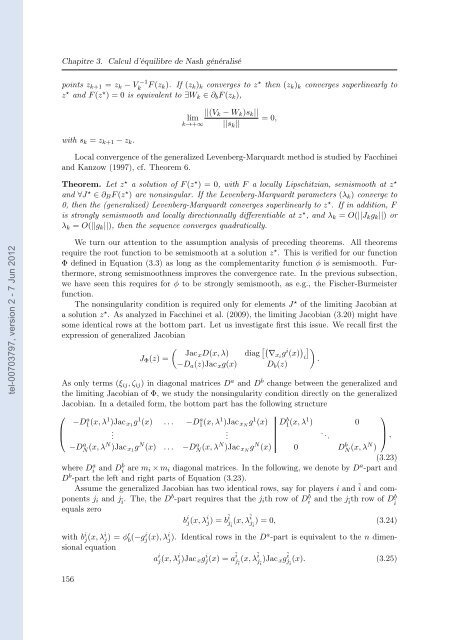Etude des marchés d'assurance non-vie à l'aide d'équilibres de ...
Etude des marchés d'assurance non-vie à l'aide d'équilibres de ...
Etude des marchés d'assurance non-vie à l'aide d'équilibres de ...
You also want an ePaper? Increase the reach of your titles
YUMPU automatically turns print PDFs into web optimized ePapers that Google loves.
tel-00703797, version 2 - 7 Jun 2012<br />
Chapitre 3. Calcul d’équilibre <strong>de</strong> Nash généralisé<br />
points zk+1 = zk − V −1<br />
k F (zk). If (zk)k converges to z ⋆ then (zk)k converges superlinearly to<br />
z ⋆ and F (z ⋆ ) = 0 is equivalent to ∃Wk ∈ ∂bF (zk),<br />
with sk = zk+1 − zk.<br />
||(Vk − Wk)sk||<br />
lim<br />
= 0,<br />
k→+∞ ||sk||<br />
Local convergence of the generalized Levenberg-Marquardt method is studied by Facchinei<br />
and Kanzow (1997), cf. Theorem 6.<br />
Theorem. Let z ⋆ a solution of F (z ⋆ ) = 0, with F a locally Lipschitzian, semismooth at z ⋆<br />
and ∀J ⋆ ∈ ∂BF (z ⋆ ) are <strong>non</strong>singular. If the Levenberg-Marquardt parameters (λk) converge to<br />
0, then the (generalized) Levenberg-Marquardt converges superlinearly to z ⋆ . If in addition, F<br />
is strongly semismooth and locally directionnally differentiable at z ⋆ , and λk = O(||Jkgk||) or<br />
λk = O(||gk||), then the sequence converges quadratically.<br />
We turn our attention to the assumption analysis of preceding theorems. All theorems<br />
require the root function to be semismooth at a solution z ⋆ . This is verified for our function<br />
Φ <strong>de</strong>fined in Equation (3.3) as long as the complementarity function φ is semismooth. Furthermore,<br />
strong semismoothness improves the convergence rate. In the previous subsection,<br />
we have seen this requires for φ to be strongly semismooth, as e.g., the Fischer-Burmeister<br />
function.<br />
The <strong>non</strong>singularity condition is required only for elements J ⋆ of the limiting Jacobian at<br />
a solution z ⋆ . As analyzed in Facchinei et al. (2009), the limiting Jacobian (3.20) might have<br />
some i<strong>de</strong>ntical rows at the bottom part. Let us investigate first this issue. We recall first the<br />
expression of generalized Jacobian<br />
<br />
Jac<br />
JΦ(z) =<br />
xD(x, λ) diag ∇xigi (x) <br />
i .<br />
−Da(z)Jac xg(x) Db(z)<br />
As only terms (ξij, ζij) in diagonal matrices D a and D b change between the generalized and<br />
the limiting Jacobian of Φ, we study the <strong>non</strong>singularity condition directly on the generalized<br />
Jacobian. In a <strong>de</strong>tailed form, the bottom part has the following structure<br />
⎛<br />
⎜<br />
⎝<br />
−D a 1 (x, λ1 )Jac x1 g1 (x) . . . −D a 1 (x, λ1 )Jac xN g1 (x)<br />
.<br />
.<br />
D b 1 (x, λ1 ) 0<br />
. ..<br />
−Da N (x, λN )Jac x1gN (x) . . . −Da N (x, λN )Jac xN gN (x) 0 Db N (x, λN )<br />
(3.23)<br />
where Da i and Db i are mi × mi diagonal matrices. In the following, we <strong>de</strong>note by Da-part and<br />
Db-part the left and right parts of Equation (3.23).<br />
Assume the generalized Jacobian has two i<strong>de</strong>ntical rows, say for players i and ĩ and components<br />
ji and jĩ . The, the Db-part requires that the jith row of Db i and the jĩth row of Dbĩ<br />
equals zero<br />
⎞<br />
⎟<br />
⎠ ,<br />
b i j(x, λ i j) = b ĩ jĩ (x, λĩj ) = 0, (3.24)<br />
ĩ<br />
with b i j (x, λi j ) = φ′ b (−gi j (x), λi j ). I<strong>de</strong>ntical rows in the Da -part is equivalent to the n dimen-<br />
sional equation<br />
156<br />
a i j(x, λ i j)Jac xg i j(x) = a ĩ jĩ (x, λĩ jĩ )Jac xg ĩ j (x). (3.25)<br />
ĩ
















